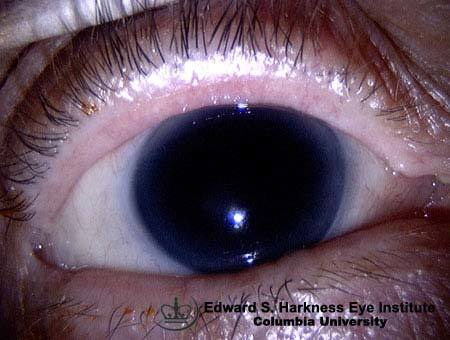CONJUNCTIVITY IN FRONTLIFTS
 Many young mothers and dads, with any redness in the eyes of a newly born baby, diagnose a conjunctivitis in it and immediately begin self-medication.What is conjunctivitis?Is the red eye always a manifestation of the baby?Are all conjunctivitis the same?Let's talk about this.
Many young mothers and dads, with any redness in the eyes of a newly born baby, diagnose a conjunctivitis in it and immediately begin self-medication.What is conjunctivitis?Is the red eye always a manifestation of the baby?Are all conjunctivitis the same?Let's talk about this.
CONCEPT AND CLINICAL SYMPTOMS OF CONJUNCTIVITY
The medical term "conjunctivitis" is a common name for various forms of the same disease, similar in their etiology, but similar in clinical manifestations.All of them are characterized by inflammation of the mucous membrane of the eyes, covering the eyelids from the inside and the eyeball in front.This mucus conjunctiva is called, and its inflammation is conjunctivitis.
Conjunctiva is very sensitive, so it reacts instantly to contact with allergens or microbes, to the effects of irritants.The mucous eye suffers with many systemic diseases.Not in the best way are reflected in its condition non-observance of rules of personal hygiene, influence of the dry and polluted air, bright light, chemical agents.
In the first month after birth, it sometimes happens that the eyes are turning sour at the baby: eyelids stick together after sleep, they form dry whitish crusts, but there is no swelling of the eyelids and redness of the conjunctiva.This is not conjunctivitis.It is enough to rinse the baby's eyes with boiled, slightly salted water, and everything comes back to normal.The newborn does not have tear glands, and the ducts connecting the tear sacks to the nasal cavity are not always well-trodden.Therefore, the eyes will cease to turn brown in the baby to 1.5-2 months, when the lacrimal glands and tear-nasal canals will begin to work at full strength.
Another reason that blush and watery eyes in the baby, - instillation in the delivery room in the eyes of the child's solution of silver nitrate for the prevention of conjunctivitis.The inflammation of the conjunctiva caused by the instillation of the drug passes without treatment within the first two days.
Clinical signs of conjunctivitis in infants:
-
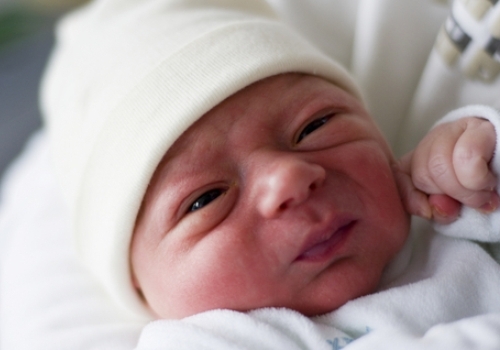 reddening of conjunctiva( red eye in infants);
reddening of conjunctiva( red eye in infants); - swelling and redness of the eyelids;
- lacrimation;
- discharge from the eyes( mucous, watery, purulent, etc.), drying out with the formation of crusts, clumping of eyelids and gluing of eyelashes;
- photophobia;
- and itchy eyes in which the baby reacts with anxiety, excitement, loud screaming, crying, refusal to eat, poor sleep.
The incidence of conjunctivitis in children and adults is approximately the same.But children under the age of one year( due to the immaturity of the immune system and other systems) are more likely than older children to have various diseases, including conjunctivitis.
Note: if the eyes of the baby get wet, blush the conjunctiva, or you notice the pus in the eyes of the baby, do not panic, but go to the children's polyclinic.If there is no way to immediately show the baby to the ophthalmologist, call the pediatrician at home.Do not try to reassure yourself that this is a banal conjunctivitis, which you can easily handle yourself.
Congenital glaucoma, dacryocystitis( inflammation of the lacrimal sac due to impassability of the lacrimal canal), uveitis( inflammation of the choroid), keratitis( inflammation of the cornea) and many other eye diseases can be concealed under the mask of conjunctivitis.All of them, and conjunctivitis in newborns, including, require the provision of qualified medical care.
CLASSIFICATION OF CONJUNCTIVITIS IN NEWBORN
All conjunctivitis in children by mechanism of occurrence are divided into allergic and non-allergic .In the prevalence of the inflammatory process, they are bilateral and one-way , according to the nature of the current - acute and chronic .
According to the etiology, namely by the type of pathogen that caused inflammation of the mucous eye, all non-allergic conjunctivitis in infants are divided into three groups:
- viral;
- bacterial;
- chlamydial.
VIRAL CONNECTIVITY
Of all non-allergic conjunctivitis, it is much more common than others.Usually develops against the background of acute respiratory viral infection and is characterized by abundant watery discharge from the eyes( lachrymation), so pus in the eyes of the baby is rarely accumulated.First, the infection affects one eye, and then the second.
Adenoviruses of some serotypes cause epidemic keratoconjunctivitis, which affects not only the conjunctiva, but also the cornea, with corneal complications developing in children much more often than in adults.Because of the edema of the eyelids, itching in the eyes, fast developing photophobia, the kid is capricious, shouts, refuses to eat and sleep.Often adenoviral conjunctivitis in infants is combined with catarrhal phenomena in the upper respiratory tract.In case of bankruptcy treatment, the disease can be complicated by opacity of the cornea and decreased visual acuity.
Enterovirus conjunctivitis is often accompanied by hemorrhages in the mucous membrane of the eye.Viruses of simple and herpes zoster rarely cause conjunctivitis in children under one year.But if this happens, then there are other signs of herpetic infection( blistering rashes on the skin, etc.).Possible complications of the disease are herpetic keratitis, defeat of the oculomotor and optic nerves, choroid of the eyeball and even loss of vision.
Newborns rarely have measles, infectious mononucleosis and mumps, but we must not forget that conjunctivitis can be one of the symptoms of these diseases.
Viral conjunctivitis in newborns, as a rule, does not require specific treatment with antiviral agents.Measures aimed at preventing the spread of infection, treating the eyes with antiseptic agents and, if necessary, maintaining the immunity of the child are shown.
BACTERIAL CONJUNCTIVES
Bacteria, as a rule, affect both eyes at once. The main symptoms of bacterial conjunctivitis:
- bright red mucous membranes of the eyes;
- abundant purulent, sometimes mucopurulent discharge from both eyes;
- marked edema of the eyelids.
Staphylococcus, streptococcus, pneumococcus, hemophilic rod, gonococci are causative agents of this type of disease.
Staphylococcal conjunctivitis is a classic example of an acute purulent process.The child becomes inflamed and swollen eyelids, eyes are watered, pus constantly accumulates in them.During sleep, purulent crusts are formed, gluing eyelids and eyelashes.The kid, suffering from rubbing and pain in his eyes, constantly screams, refuses to eat, restlessly sleeps.
Conjunctivitis caused by pneumococcus, is an acute and lasting no more than two weeks process.On the eyelids there is a small-point rash, they swell drastically, a whitish film forms in the eyes of the pus.All these symptoms develop against a background of high body temperature and deterioration of the baby's well-being.
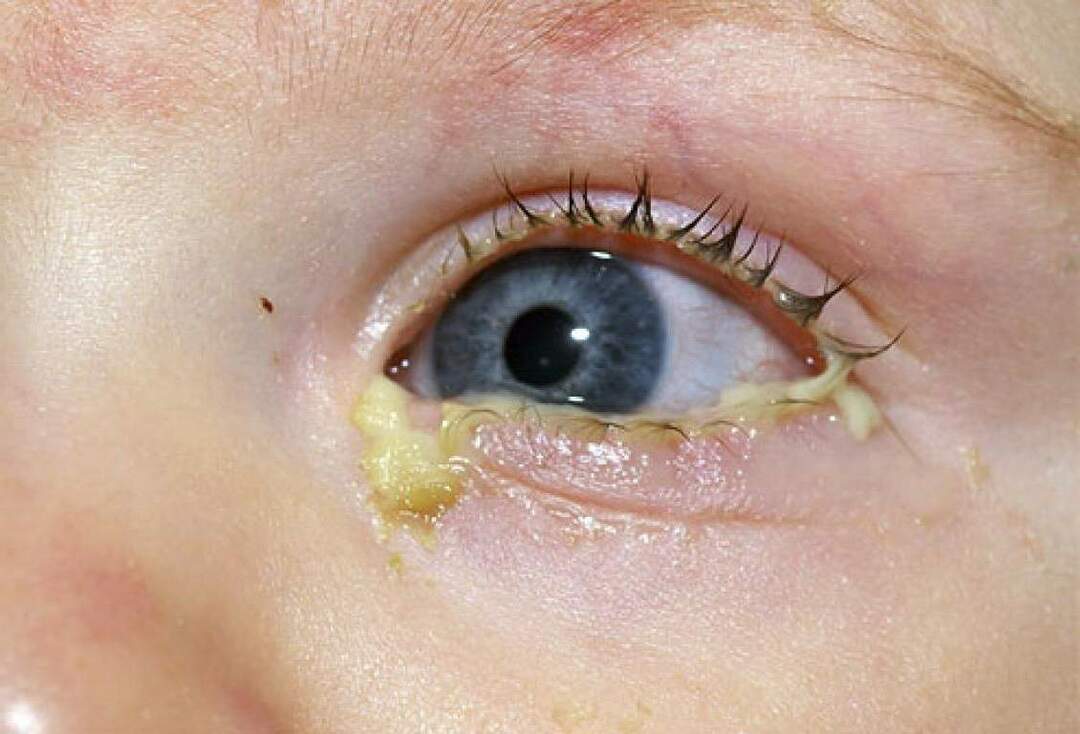 A serious danger to the newborn is represented by gonococcal conjunctivitis, which he can get from the mother if she is ill with gonorrhea.It manifests itself in the first 1-2 days( sometimes up to 5 days) after birth with edematous eyelids and serous-bloody discharge from the eyes, which thickens and becomes purulent during the day.There is marked reddening of the conjunctiva, the eyelids are dense when palpating.
A serious danger to the newborn is represented by gonococcal conjunctivitis, which he can get from the mother if she is ill with gonorrhea.It manifests itself in the first 1-2 days( sometimes up to 5 days) after birth with edematous eyelids and serous-bloody discharge from the eyes, which thickens and becomes purulent during the day.There is marked reddening of the conjunctiva, the eyelids are dense when palpating.
In this situation, emergency diagnosis of the disease( detection of the gonococcus in the discharge from the eyes) and timely treatment started are of utmost importance.Otherwise, the infection penetrates deeply into the conjunctiva, affects the cornea, leads to the development of formidable complications, such as: corneal ulcers and perforation, iridocyclitis, total inflammation of all eye structures( panophthalmitis).The most serious consequence is blindness.
It is extremely rare in newborns to diagnose diphtheria conjunctivitis , which develops against the background of the same-name infectious disease.It differs from other eye lesions formation on the surface of the mucous membrane of gray-white fibrin films, after removal of which the conjunctiva bleeds.Such films can be formed in chlamydial, viral and other bacterial conjunctivitis, which are therefore called pseudodipteria.The main difference between them and diphtheria is that after removal of the films, the mucosa remains smooth and does not bleed.
Important: and bacterial and viral conjunctivitis are acute infectious diseases!Therefore, if the baby is sick, allocate to him individual items and tools for treating the eyes to protect the remaining members of the family from infection.
CHLAMIDIC CONJUNCTIVITY
Infection of the kid with chlamydia occurs during childbirth or after them from a sick mother.This determines the timing of the onset of clinical symptoms: in the first days after birth or later.The incubation period can last up to 1-2 weeks.The first sign of chlamydial eye damage is often the child's unreasonable anxiety caused by pain in the eyes.And only then the eyelids swell and there are purulent discharge from the eyes.They are so abundant that even repeated washing does not always help.Cornea with chlamydial inflammation is rarely affected.
Detection of the pathogen is possible with the method of immunofluorescence analysis.Treatment involves the appointment of antimicrobial agents.The mother of a sick child and her sexual partner should also be examined and treated.
ALLERGIC CONJUNCTIVES
Recommended to read: 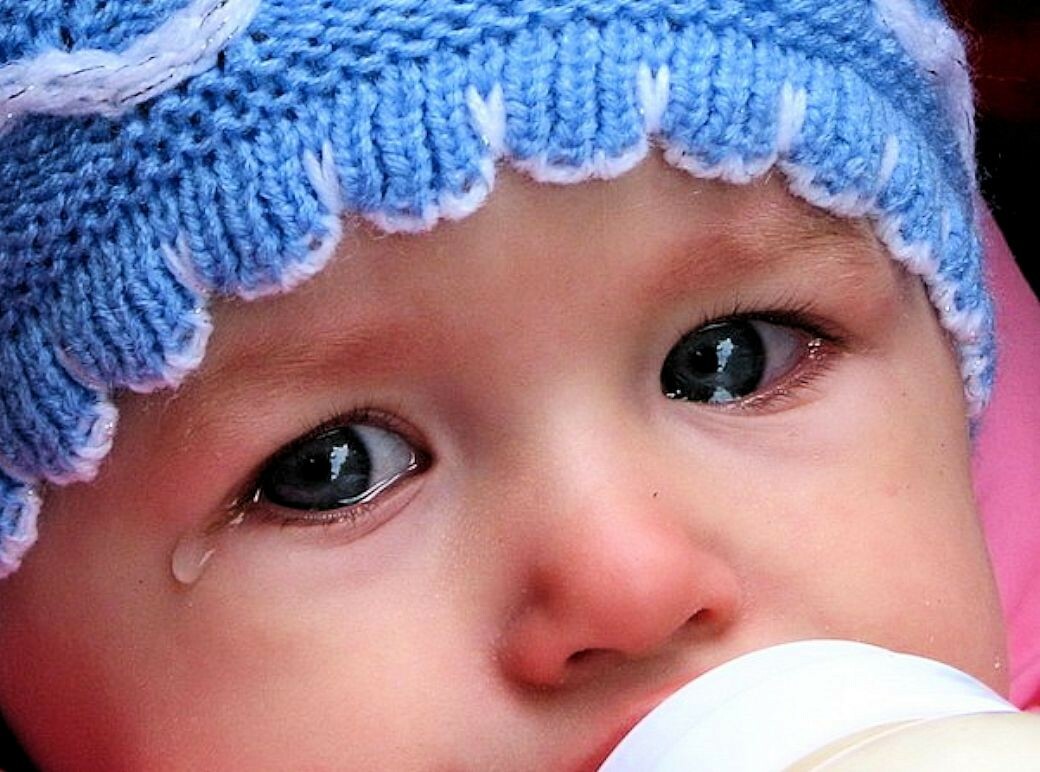 Allergic reaction from the conjunctiva in newborns can cause dust, animal hair, bedding, cleaning supplies, etc. Inflammation of the eye mucosa may be isolated or combined with allergic rhinitis.
Allergic reaction from the conjunctiva in newborns can cause dust, animal hair, bedding, cleaning supplies, etc. Inflammation of the eye mucosa may be isolated or combined with allergic rhinitis.
The main manifestations of the disease - this is redness of the eyes, puffiness of the eyelids, lacrimation, severe itching.When attaching a bacterial infection, the discharge from the eyes becomes purulent.How does the baby react to all this?He is capricious, loudly screaming, sucking badly, waking up and crying in his sleep.
Important: prognosis for conjunctivitis largely depends on how quickly the cause of the disease is established and really effective treatment is prescribed.This can only be done by a specialist.So do not experiment with your baby's health, do not self-medicate.Do not forget that any conjunctivitis is always a potential risk of developing blindness.At the first signs of trouble, ask for help from a pediatrician or ophthalmologist.
BASIC PRINCIPLES OF TREATMENT
The basis for the treatment of bacterial conjunctivitis is the administration of antibacterial agents in the form of ointments, solutions for instillations, and if necessary, oral suspensions.It is very good, if it is possible to conduct a bacteriological study of a purulent discharge from the eyes and to establish which preparations are sensitive to the pathogen of infection.
Do not be afraid to use drops and ointments containing antibiotics.Only they, and not herbal decoctions or tea lotions, can cope with a purulent infection and prevent the development of complications of bacterial conjunctivitis.Folk remedies are just a good addition to drug therapy.
In the treatment of allergic conjunctivitis, the main thing is to identify the allergen and stop the child's contact with it.Relieve the course of the disease cool compresses on the eyes.Locally used anti-edemas, antihistamines and anti-inflammatory drugs.If there are indications, the doctor prescribes medicinal forms for oral administration.
Cure viral conjunctivitis is not always possible with anti-inflammatory and antiseptic agents.In some cases, still have to use ointments and drops with antiviral activity.
Useful advices:
- , in anticipation of the examination of a sick child by a doctor, wash the eyes of the baby with a warm decoction of chamomile or calendula, slightly boiled tea or a solution of furacilin.Use a sterile cotton wool for this;
- for each procedure, pour a small amount of washing liquid into a separate container;
- each eye rinse with a separate swab from the outer corner of the eye to the inside;
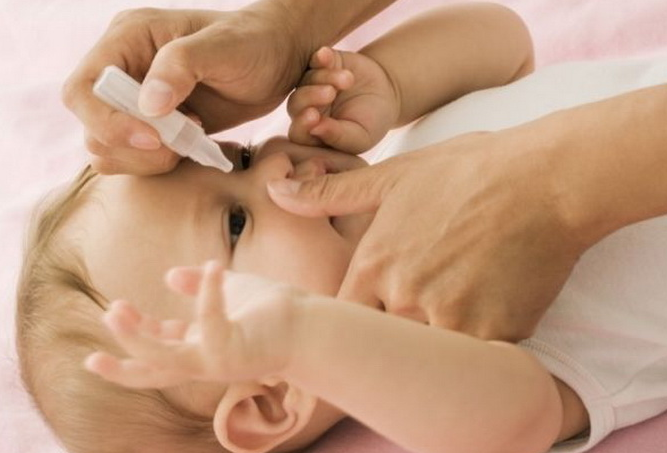
- Never re-insert the tampon in the washing liquid;
- with unilateral conjunctivitis treat both eyes: first healthy, and then sick;
- after examining the baby by a pediatrician or ophthalmologist strictly follow the doctor's recommendations: correctly dose the medications and observe the prescribed multiplicity of their application;
- with the improvement of the baby's health can reduce the number of washes.Do not stop using medicines until they are canceled by the doctor;
- before each eye treatment, do not forget to wash your hands with soap and water.
PREVENTION OF CONDITION
In a maternity hospital, doctors are taking care of the prevention of conjunctivitis in newborns.
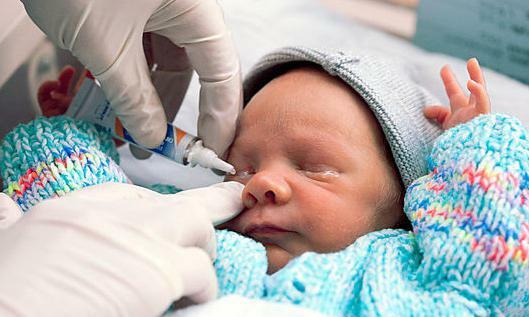
And after the discharge home all responsibility falls on the parents of the baby.
Advice to parents:
- Do not forget to wash your hands with soap before every communication with the baby;
- use only personal and hygiene products for child care;
- wash it with boiled water only;
- exclude the contact of the baby with the sick family members, and use a protective medical mask;
- do not allow pets to enter the newborn;
- regularly hold a wet cleaning in the children's room and ventilate it;
- do not visit places with a large population of children;
- use only special detergents for washing baby clothes;
- monitor the humidity in the room where the baby is.If necessary, purchase a humidifier.
Zaluzhanskaya Elena Aleksandrovna, pediatrician



